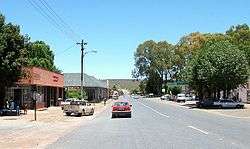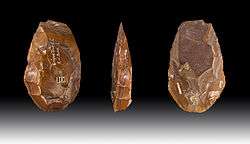Griekwastad
| Griekwastad | |
|---|---|
 Road in Griekwastad | |
 Griekwastad  Griekwastad Griekwastad (South Africa)  Griekwastad Griekwastad (Africa) | |
| Coordinates: 28°51′S 23°15′E / 28.850°S 23.250°ECoordinates: 28°51′S 23°15′E / 28.850°S 23.250°E | |
| Country | South Africa |
| Province | Northern Cape |
| District | Pixley ka Seme |
| Municipality | Siyancuma |
| Established | 1812[1] |
| Area[2] | |
| • Total | 77.74 km2 (30.02 sq mi) |
| Population (2011)[2] | |
| • Total | 6,428 |
| • Density | 83/km2 (210/sq mi) |
| Racial makeup (2011)[2] | |
| • Black African | 33.3% |
| • Coloured | 60.2% |
| • Indian/Asian | 0.5% |
| • White | 3.8% |
| • Other | 2.2% |
| First languages (2011)[2] | |
| • Afrikaans | 95.4% |
| • Tswana | 2.3% |
| • Other | 2.4% |
| Time zone | UTC+2 (SAST) |
| Postal code (street) | 8365 |
| PO box | 8365 |
| Area code | 053 |
| Historical states in present-day South Africa |
|---|
 |
|
before 1600
|
|
1600–1700
|
|
1700–1800
|
|
1800–1850
|
|
1850–1875
|
|
1875–1900
|
|
1900–present
|
|
|
Griekwastad (Afrikaans for "Griqua city") is a country town in South Africa. It is sometimes still called Griquatown, a name which is now considered historical. The town is in the Northern Cape Province of South Africa 168 kilometres (104 mi) by road[3] west from the city of Kimberley. It was the first town to be established in the country north of the Orange River.

History
In 1801 William Anderson and Cornelius Kramer, of the London Missionary Society, established a station among the Griqua at Leeuwenkuil. The site proved too arid for cultivation. In about 1805 they moved the station to another spring further up the valley and called it Klaarwater. Their second choice was little better than their first, and for many years a lack of water prevented any further development. The name of the settlement was changed later to Griquatown or Griekwastad in Afrikaans. They lived among a mixed nomadic community of the Chaguriqua tribe and "bastaards" (people of mixed origin) from Piketberg. Their two leaders Andries Waterboer and Adam Kok II later had a dispute and Kok left for Philippolis.
From 1813 to 17 July 1871, the town and its surrounding area functioned as Waterboer's Land. Waterboer himself lived in a "palace", which in reality was a house with six rooms. A monument for Waterboer was later erected near the town's hospital.
Dr. Robert Moffat and his wife Mary, on their way to the town of Kuruman, were residing in Griquatown when their daughter, also Mary (later Mrs. David Livingstone), was born in 1821. There is now a museum that is dedicated to her rather than the founder of the town, William Anderson.
That Griekwastad was later the capital of British Colony Griqualand West from 1873 to 1880, with its own flag and currency, before it was annexed into the Cape Colony. During the Apartheid era from 1969 till 2001, it was the garrison of the 4 Armoured Regiment, an SADF Tank Battalion equipped with Eland Mk7 Tanks[4]
Nowadays, the town is best known for the semi-precious stones found there, particularly tiger's eye and jasper. Sheep farming occurs with dorpers, a South African breed, which can now be found in places such as Australia.
Crime
An infamous murder in Griekwastad took place on a farm on Easter Friday, 2012. A 15-year-old youth was accused of the murders of Northern Cape farmer Deon Steenkamp, 44, his wife Christelle, 43, and daughter Marthella, 14. The son, Don Steenkamp, aged 17, the only surviving member and brother to Marthella, stood to inherit a sizable share of the inheritances. [5]
References
- ↑ "Chronological order of town establishment in South Africa based on Floyd (1960:20-26)" (PDF). pp. xlv–lii.
- 1 2 3 4 "Main Place Griekwastad". Census 2011.
- ↑ Distances from Griekwastad
- ↑ "British Empire: The Map Room: Griqualand West". britishempire.co.uk. August 27, 2007. External link in
|publisher=(help) - ↑ http://www.news24.com/SouthAfrica/News/Griekwastad-teen-to-inherit-R23m-20130424
.svg.png)